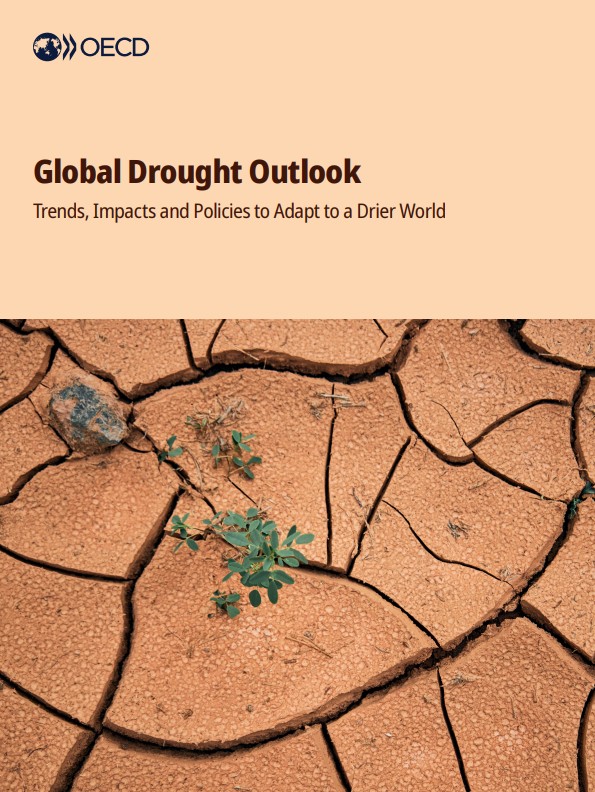
목차
Title page 1
Contents 6
Preface 4
Foreword 5
Abbreviations and acronyms 9
Executive summary 10
1. Introduction 12
1.1. Droughts: a growing threat to people, ecosystems, and economies 12
1.2. A global momentum for adapting to drought 13
1.3. Objectives of this report 14
References 15
Notes 15
2. Towards a drier world 16
2.1. Introduction 17
2.2. Understanding drought risk 17
2.2.1. What is drought? 17
2.2.2. Observed changes in drought conditions 19
2.2.3. Observed trends in freshwater availability 20
2.2.4. Observed trends in compound and consecutive climate events 24
2.3. The drivers of changing drought hazard 24
2.3.1. Climatic drivers of drought 24
2.3.2. Anthropogenic (non-climatic) drivers of drought 28
2.4. Towards a drier world 32
2.4.1. Growing drought frequency, duration, and intensity 32
2.4.2. Projected impacts on soil moisture, groundwater levels, and river flows 37
References 39
Notes 46
3. Impacts and costs of droughts 48
3.1. Introduction 49
3.2. Impacts of droughts on ecosystems 50
3.2.1. The impact of droughts on vegetation 50
3.2.2. The impact of droughts on fauna 54
3.2.3. The impact of drought on water quality and land degradation 55
3.3. The economic impacts of droughts 56
3.3.1. Impacts on the agricultural sector 56
3.3.2. Beyond agriculture: impacts of droughts on other economic sectors 59
3.3.3. Losses and damages 61
3.3.4. Macroeconomic effects 65
3.4. Beyond the economy, beyond borders 67
3.4.1. Droughts and migration flows 68
3.4.2. Droughts, environmental security and conflicts 71
References 74
Notes 81
4. Adapting to drought risk for long-term resilience 83
4.1. Introduction 84
4.2. Adapting to growing drought risk through strategic planning 86
4.2.1. National policy frameworks for drought resilience 86
4.2.2. Informing drought management with climate risk assessments 88
4.3. Policy measures and instruments for enhancing drought resilience 89
4.3.1. Managing water demand and supply for drought resilience 90
4.3.2. Managing land and ecosystems for drought resilience 102
4.3.3. Adapting sectoral practices to climate change 106
4.4. Building institutional and financing frameworks for drought resilience 112
4.4.1. Strengthening collaboration for drought resilience 112
4.4.2. Scaling up finance for drought resilience 116
4.4.3. Harnessing insurance for drought resilience 117
References 119
Notes 135
Annex A. Details on OECD countries' exposure to drought 138
References 139
Annex B. Details on drought indicators 140
References 140
Tables 7
Table 3.1. Studies on droughts, precipitation shocks and crops 57
Table 3.2. Meta-studies in climate change and migration 68
Table 3.3. Migration studies involving drought-relevant explanatory variables 69
Table 3.4. Droughts as a potential contributing factor to recorded conflicts 72
Table 3.5. Environmental security studies spotlighting drought-relevant drivers 73
Table 4.1. Drought risk focus in NAPs and NAS of selected OECD countries 88
Table 4.2. The three components of drought risk assessment 89
Table 4.3. Selected water pricing mechanisms relevant for drought prevention 94
Table 4.4. Overview of selected water supply measures and their benefits 96
Table 4.5. Country experiences in government support for rainwater harvesting 100
Table 4.6. Country experiences in supporting water recycling 101
Table 4.7. Overview of landscape-wide ecosystem management practices and their benefits 104
Table 4.8. Overview of urban NbS for drought resilience and their benefits 106
Table 4.9. Overview adaptive practices to enhance the resilience of farming systems 109
Table 4.10. Overview of sustainable land and water management practices and their benefits 110
Table 4.11. Overview of adaptive waterway transport practices and their benefits 111
Table 4.12. Overview adaptive practices to prevent damage to physical assets and their benefits 112
Table 4.13. Government-supported insurance schemes for drought resilience in selected countries 118
Figures 7
Figure 2.1. Drought types and their drivers 18
Figure 2.2. Share of global land area affected by droughts (1900-2020) 19
Figure 2.3. Change in drought frequency and intensity (1950-2000 vs 2000-2020) 20
Figure 2.4. Change in agricultural drought conditions in OECD countries and at the global level (1980-2023) 21
Figure 2.5. Number of river low-flow days in Australia (1980-2000 vs 2000-2020) 22
Figure 2.6. Trends in monitored groundwater levels in the United States (2000-2020) 23
Figure 2.7. Global trends in average precipitation levels 25
Figure 2.8. Trends in global precipitation, temperature, and potential evaporation rates (1900-2020) 27
Figure 2.9. Change in the frequency of extreme precipitation deficit and extreme temperature years 28
Figure 2.10. Impact of human activities on drought risk 29
Figure 2.11. Irrigation capacity and water use in agricultural in OECD countries (2001-2020) 30
Figure 2.12. Change in land cover in OECD countries 32
Figure 2.13. Projected changes in annual temperature and precipitation levels over time 33
Figure 2.14. Global temperature change and greenhouse gas emission across SSP scenarios 34
Figure 2.15. Projected change in average global drought frequency, duration, and intensity 35
Figure 2.16. Projected changes in global drought conditions by 2050 and 2100 37
Figure 2.17. Projected changes in average agricultural drought conditions over time 38
Figure 2.18. Projected changes in drought conditions across different climate scenarios 39
Figure 3.1. Soil moisture anomalies and their impacts on vegetation productivity 51
Figure 3.2. The relationship between precipitation and vegetation productivity 52
Figure 3.3. Estimated crop losses due to soil moisture anomalies 53
Figure 3.4. Agricultural production loss from drought conditions in the United States 58
Figure 3.5. Agricultural production loss from precipitation shocks 59
Figure 3.6. The economic costs of drought episodes 63
Figure 3.7. The relative frequency of recorded losses and damages in the United States 64
Figure 3.8. Trends in drought-related costs in the United States 65
Figure 3.9. Negative precipitation shocks and their potential effects on regional GDP 66
Figure 4.1. The triple dividend of adapting to drought 85
Figure 4.2. Drought management plans in OECD countries 86
Figure 4.3. Average price for drinking water in selected countries (EUR/m3), 2022 95
Figure 4.4. Share of wasted water in selected European countries' water distribution systems 98
Figure 4.5. The benefits of sustainable soil and ecosystem management 103
Boxes 8
Box 2.1. Projecting drought risk under different climate and socioeconomic scenarios 34
Box 4.1. Innovative approaches to drought resilience in subnational policy frameworks 87
Box 4.2. The challenges posed by unsustainable water abstraction 91
Box 4.3. Integrating ecological flow considerations in water allocation regimes 92
Box 4.4. Avoiding maladaptation: The controversial role of reservoirs and water transfers 97
Box 4.5. International initiatives to address drought risk through land and ecosystem restoration 105
Box 4.6. The EU River Basin Management Plans (RBMPs) 114
Box 4.7. International initiatives for integrated drought management 115
Box 4.8. Index-based insurance: evolving products for drought resilience in agriculture 119
Annex Tables 8
Table A A.1. Change in OECD countries' exposure to droughts 138
Table A B.1. Indicators used to assess drought trends and their drivers 140



